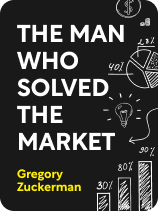

This article is an excerpt from the Shortform book guide to "The Man Who Solved the Market" by Gregory Zuckerman. Shortform has the world's best summaries and analyses of books you should be reading.
Like this article? Sign up for a free trial here.
What is The Man Who Solved the Market by Gregory Zuckerman about? How did Jim Simons impact the financial market?
Gregory Zuckerman’s book The Man Who Solved the Market is the story of Jim Simons, a mathematician who became a billionaire hedge fund manager just by recognizing predictable patterns in the market. His work has made him one of the greatest investors on Wall Street.
Read below for a brief The Man Who Solved the Market book overview.
The Man Who Solved the Market by Gregory Zuckerman
In The Man Who Solved the Market book, business journalist Gregory Zuckerman tells the story of Jim Simons, a former mathematician who became one of the most successful hedge fund managers in history. Hedge funds are investment vehicles that bear some similarities to mutual funds—they pool investments from investors, and those investors earn returns from the fund in proportion to the amount they’ve invested. But unlike typical mutual funds, hedge funds are only open to very high-net-worth individuals; require a high level of minimum investment; and, most importantly, employ a range of alternative and often high-risk investment strategies to earn investors higher returns.
Simons founded his hedge fund, Renaissance Technologies, in the late 1970s. What set Renaissance apart was Simons’s insight that price fluctuations within financial markets followed recognizable and predictable patterns. When identified, these patterns could be used to strategically buy and sell the right stocks, bonds, currencies, and other financial instruments at the right time.
Part 1: A Love of Mathematics
Jim Simons was born in 1938 to a middle-class Jewish family in Brookline, Massachusetts, a suburb of Boston. Intellectually curious from a young age, writes Zuckerman, Simons discovered an early passion for mathematics. Where some find aesthetic beauty in nature or in great works of literature, Zuckerman writes that Simons found beauty and elegance in mathematics. He was inspired by the unity and connection of different fields within mathematics and the idea that formulas, equations, and theorems could be the keys that unlocked the mysteries of the observable universe. He dreamed that solving these mathematical mysteries could point the way toward discovery of deeper, universal truths.
In this section, we’ll explore how this adolescent passion for mathematics influenced his early career in academia, code-breaking for the US government, and financial trading.
An Intellectual Pursuit
As a student, writes Zuckerman, Simons was interested in mathematics purely as an intellectual pursuit. He was motivated by the challenge of solving problems, the thrill of new discoveries, and the exploration of unsolved mysteries. At this age, he had little interest in—or conception of—the application of mathematics to the “real” world or how he could harness it for personal financial gain. Although money and wealth had a certain allure to Simons as a young man, mathematics for its own sake was his abiding passion.
Discovering Investing
Zuckerman writes that Simons began to discover the exhilaration and thrill of investing in his early 20s. While completing his doctoral program at the University of California, Berkeley, he made a few preliminary trades by investing in soybean futures.
After earning some initial profits when the price of soybeans skyrocketed, Simons—ignoring a friend’s advice about the volatility of commodities prices—held onto his investment too long and saw his profits evaporate when soybean prices tumbled. But the experience was his first entry into the world of investing that would later define his life—and make his fortune.
Breaking Codes at the IDA
After completing his doctoral thesis at Berkeley in 1962 and publishing his first mathematical paper that year, Simons took a job as a codebreaker with the Institute for Defense Analyses (IDA), a nonprofit research organization with close ties to the United States government.
Working there from 1964 through 1968, at the height of the Cold War between the United States and the Soviet Union, Simons’s job was to sift through reams of coded Soviet messages and signals to identify patterns. Once Simons and his intelligence analyst colleagues could identify the Soviet patterns of communication, they could unlock the meaning of those communications and gain crucial intelligence on Soviet actions—such as where they might be moving troops, diplomatic personnel, or military hardware.
Part 2: Launching Renaissance
Although Simons learned valuable skills at the IDA and made critical contacts, he was fired from his position as a codebreaker there in 1968, due to his public opposition to the Vietnam War. At 30 years old with a wife and children, writes Zuckerman, Simons still saw himself fundamentally as a mathematician and academic who thrived in the company of other similarly minded individuals. In this section, we’ll explore how Simons transitioned from an intellectually minded academic to a wildly successful and wealthy captain of finance. Specifically, we’ll look at his time as a mathematics chair on Long Island in the 1970s; his founding of Renaissance in 1978; and the extraordinary, market-beating growth of Renaissance in the 1980s.
Mathematics Chair at Stony Brook
In 1968, Simons took a job as the mathematics chair at the State University of New York at Stony Brook, on Long Island, where he stayed until 1978. There, his connections and keen eye for talent helped him build a first-rate mathematics department, transforming Stony Brook from a little-known public university into a mathematics powerhouse that could hold its own with Ivy League universities. While at Stony Brook, Simons continued his academic work, publishing groundbreaking mathematics papers that cemented his reputation as a leading pure mathematician of his time.
Importantly, writes Zuckerman, Simons also recruited many scholars he’d known at Berkeley to Stony Brook, as well as former IDA colleagues. Many of these hires would in turn become colleagues and investors at Simon’s future hedge fund, Renaissance.
Seeking a New Challenge
In 1978, Simons shocked his friends when he announced his intention to leave academia and start his own fund. Despite his success and popularity at Stony Brook, Simons never quite lost the itch for investing he’d developed as a younger man—whether it had been experimenting with futures contracts in the early 1960s or building mathematical trading models with his IDA colleagues. The rush, the thrill, the attraction of using his quantitative abilities and elite standing within the mathematics world to make money seemed like a way to put pure mathematics into action.
Finding Signals in the Noise
Simons launched his fund in 1978. It sported an atypical look for what would become one of the most successful hedge funds of all time—far from the glittering towers of Wall Street and the glamor of Manhattan, Simons started his operation out of a strip mall on Long Island. And the shabbily dressed, scruffy, academic Simons hardly looked the part of a finance power player.
The fund, initially named Monometrics (the name was changed to Renaissance in 1982), built on the investment model Simons had begun experimenting with back in his IDA days. It focused on buying or selling currencies at the right time based on the model’s predictions of when they were most likely to rise or fall in value—predictions derived from quantitative analysis and statistical modeling of historical price data.
It was, as Zuckerman writes, the logical extension of Simons’s work as a mathematician and codebreaker: finding patterns, structure, signals, and meaning in the seemingly random data. Based on the condition or phase of the market at a given time, the model could create a probability distribution mapping out the likelihood of different sets of subsequent outcomes. From this, the model could assess which assets or commodities were likely to increase in value over a certain period of time and which were likely to decrease in value.
Early Success
Zuckerman writes that, within a few years, the mathematical modeling strategy paid off for Simons: Although still flying largely under the radar, the fund attracted clients and investors, growing by tens of millions of dollars. Simons used rigorous mathematical modeling and the nascent power of computing to test and refine his models as they absorbed new data—the building blocks of what, decades later, would be called machine learning. And in this effort, he tapped the minds of his mathematician colleagues—people like Lenny Baum, who built the original fund algorithm that directed the fund to buy or sell certain assets based on observed price movements; and James Ax, who helped build the fund’s computer trading system that enabled the firm to execute those timely trades.
Increasing the Trade Volume
By the mid-1980s, Simons and Renaissance were getting closer to a truly automated trading system due to cheaper and more powerful computers and access to new microdata. These enabled the fund to capitalize on intraday trading fluctuations, broken down by hours and minutes, which optimized the algorithms and made them more robust. And these intraday fluctuations pointed to the need for the fund to massively increase its volume of daily trading to capitalize on these short-term movements—to make the model agile and responsive enough to buy and sell assets within minutes or seconds.
Zuckerman writes that Simons also believed more frequent trading would reduce risk: With more trades, there would be less risk associated with each individual trade. The negative effects of a “bad” trade would be minimized, since the model didn’t need to “win” every trade to make a profit—it just needed to win the majority of them.
The key to the strategy’s success was learning to trust the model’s predictions based on the computer’s analytics of historical data. It wasn’t necessary to know anything substantive about the underlying bonds, commodities, or currencies being traded or why their prices fluctuated the way they did: What mattered was the integrity of the data and the reliability of the patterns identified by the algorithm. If the algorithm could detect a non-random pattern and make bets that paid off more often than not, the fund would invest even if it followed no apparent economic logic.
Part 3: Simons Hits His Stride and the Quant Era Begins
The Renaissance strategy proved prescient as computer power increased in the 1990s, writes Zuckerman. Since the computers could process more data, the fund’s models became stronger, faster, and more comprehensive. By the early 1990s, returns started hitting upwards of 70%—beating the market by a wide margin. By 1993, the fund was managing over $280 million. In this section, we’ll explore how Renaissance used machine-learning principles to refine its trading code and how Simons’s mathematics-based investing strategy eventually took over the finance industry.
Mercer and Brown Join Renaissance
In 1993, writes Zuckerman, Simons hired computer scientists Peter Brown and Robert Mercer, renowned for their groundbreaking work in IBM’s language recognition unit. Simons recognized that these two scientists had experience and insight that could be of great value to Renaissance. This was because language recognition software depended on the same recognition of “states” in language as Renaissance’s model depended on recognizing market “states.” Just as a certain sequence of price movements could yield reasonable predictions about the next price movement, so could a certain sequence of words yield a reasonable prediction about the next word.
With their expertise in designing big systems, the pair were tasked with establishing a single trading code to handle Renaissance’s stock-trading business, constructing an optimal set of stock holdings given the fund’s risk appetite and financial resources. Best of all, Mercer and Brown designed the code based on machine learning principles: It would be adaptive, able to synthesize new information on the fly. The code was vastly more complex than the company’s previous code by several orders of magnitude, but it proved a winner for Renaissance: The fund was managing $900 million by 1997 and $5 billion by the mid-2000s.
The Quant Era on Wall Street
By the mid-2000s, the quant era had dawned on Wall Street. Rigorous mathematical models that analyzed the entire market were now the only way to beat the market. The financial world had at last taken notice of the emerging powerhouse fund run by the unusual collection of dressed-down mathematicians, computer scientists, and academics that was beating Wall Street at its own game. When Simons stepped down from Renaissance in 2009, he had amassed a personal fortune of $11 billion and rewritten the rules on Wall Street. His fund’s record of performance was untouchable, having consistently outperformed the market over nearly 30 years.
And in doing so, writes Zuckerman, Simons remade Wall Street in his image. The big firms that scoffed at his approach in the late 1970s and early 1980s had all to some degree or another adopted his quantitative and mathematics-based strategy by the dawn of the 2020s. From Fidelity to Merrill to the major banks, global financial institutions were investing the Renaissance way: absorbing megadata, building robust machine learning models to anticipate barely perceptible price movements, and creating computer models to automatically trade at scale based on those models.
Zuckerman writes that the datafication of everything will only make quantitative investing more powerful and dominant in the years and decades ahead. Data, after all, is the cornerstone of this investment strategy: And more data means more to analyze, more patterns to identify, and more tiny price fluctuations to capitalize on.

———End of Preview———
Like what you just read? Read the rest of the world's best book summary and analysis of Gregory Zuckerman's "The Man Who Solved the Market" at Shortform.
Here's what you'll find in our full The Man Who Solved the Market summary:
- The story of Jim Simons, one of the most successful hedge fund managers ever
- How Simons' experience as a codebreaker helped him succeed
- How Simons set the stage for today's large-scale, automated trading






